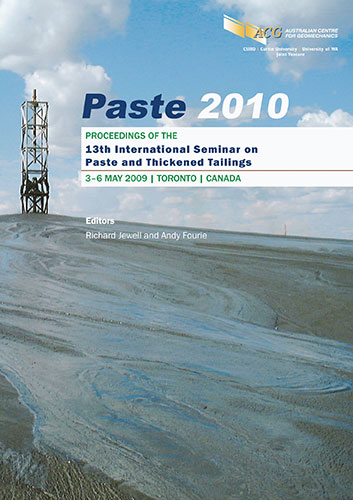Ensuring the credibility of thickening technology

|
Authors: Jewell, RJ |
DOI https://doi.org/10.36487/ACG_rep/1063_2_Jewell
Cite As:
Jewell, RJ 2010, 'Ensuring the credibility of thickening technology', in R Jewell & AB Fourie (eds), Paste 2010: Proceedings of the Thirteenth International Seminar on Paste and Thickened Tailings, Australian Centre for Geomechanics, Perth, pp. 23-31, https://doi.org/10.36487/ACG_rep/1063_2_Jewell
Abstract:
Advances in thickening technology over recent years have made possible the production of tailings at underflow densities that were previously unattainable. The potential in terms of increased water recovery within the plant and TSF storage efficiency in above ground storages is a major factor in the increasing interest by mine operators in adopting the technology in new operations as well as retrofitting existing operations. There are a number of practical issues related to being able to consistently achieve design underflow densities from the new generation of thickeners in particular. There is also evidence that in a number of cases the predictions of beach slopes for high yield stress tailings may be overly optimistic when compared with field observations. The extra costs involved in thickening tailings must be balanced against the benefits to be gained from the technology and it is necessary to ensure that the designed product can be produced consistently. The downside of not meeting design targets could significantly affect the credibility of the technology and delay ongoing implementation.
References:
Hohne, J., Bedell, D. and Fogwell, G. (2004) Ekapa Mining Success Story using the Dorr-Oliver Eimco Deep Cone
Paste Thickener, In Proceedings of the International Seminar on Paste and Thickened Tailings, Paste 2004, Paper
14, 16 p.
Jewell, R.J. and Fourie, A.B. (2006) Paste and Thickened Tailings – A Guide, Second Edition, Australian Centre for
Geomechanics, Perth, Australia, 255 p.
Luppnow, D., Moreno, J. and Palape, M. (2009) Control and Management of Thickened Tailings Beach – A Simplified
Approach, In Proceedings Twelfth International Seminar on Paste and Thickened Tailings, Australian Centre for
Geomechanics, Perth, Australia, pp. 245–269.
McPhail, G.I. (2007) Osborne High Density Discharge – An Update from 2004, In Proceedings Tenth International
Seminar on Paste and Thickened Tailings, Australian Centre for Geomechanics, Perth, Australia, pp. 339–350.
McPhail, G.I. (2008) Prediction of the Beach Profile of High-Density Thickened Tailings from Rheological and Small-
Scale Trial Deposition Data, In Proceedings Eleventh International Seminar on Paste and Thickened Tailings,
Australian Centre for Geomechanics, Perth, Australia, pp. 179–188.
Robinsky, E.I. (1999) Thickened Tailings Disposal in the Mining Industry, E.I. Robinsky Associates Limited, Canada.
Shuttleworth, J.A., Thompson, B.J. and Wates, J.A. (2005) Surface Paste Disposal at Bulyanhulu Practical Lessons
Learned, In Proceedings International Seminar on Paste and Thickened Tailings, Australian Centre for
Geomechanics, Perth, Australia, pp. 207–218.
Williams, M.P.A., Murphy, S.D., MacNamara, L. and Khoshniaz, N. (2006) The Miduk Copper Project: Down-Valley
Discharge of Paste Thickened Tailings, Design and Early Operating Experience, In Proceedings Ninth
International Seminar on Paste and Thickened Tailings, Australian Centre for Geomechanics, Perth, Australia,
pp. 117–130.
Williams, M.P.A., Seddon, K.D. and Fitton, T.G. (2008) Surface Disposal of Paste and Thickened Tailings – A Brief
History and Current Confronting Issues, In Proceedings Eleventh International Seminar on Paste and Thickened
Tailings, Australian Centre for Geomechanics, Perth, Australia, pp. 143–164.
Ensuring the credibility of thickening technology R.J. Jewell
32 Paste 2010, Toronto, Canada
© Copyright 2026, Australian Centre for Geomechanics (ACG), The University of Western Australia. All rights reserved.
View copyright/legal information
Please direct any queries or error reports to repository-acg@uwa.edu.au
View copyright/legal information
Please direct any queries or error reports to repository-acg@uwa.edu.au